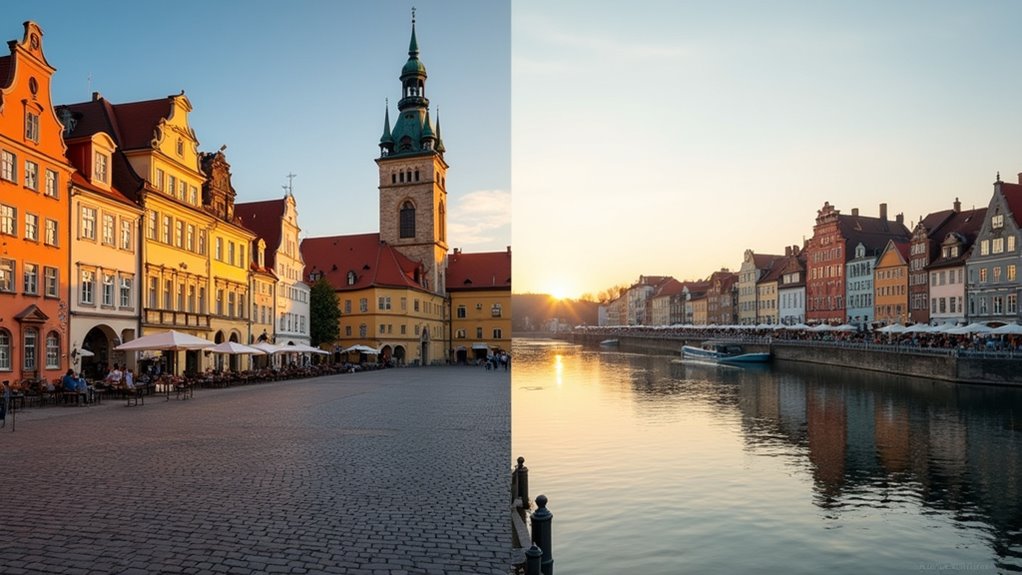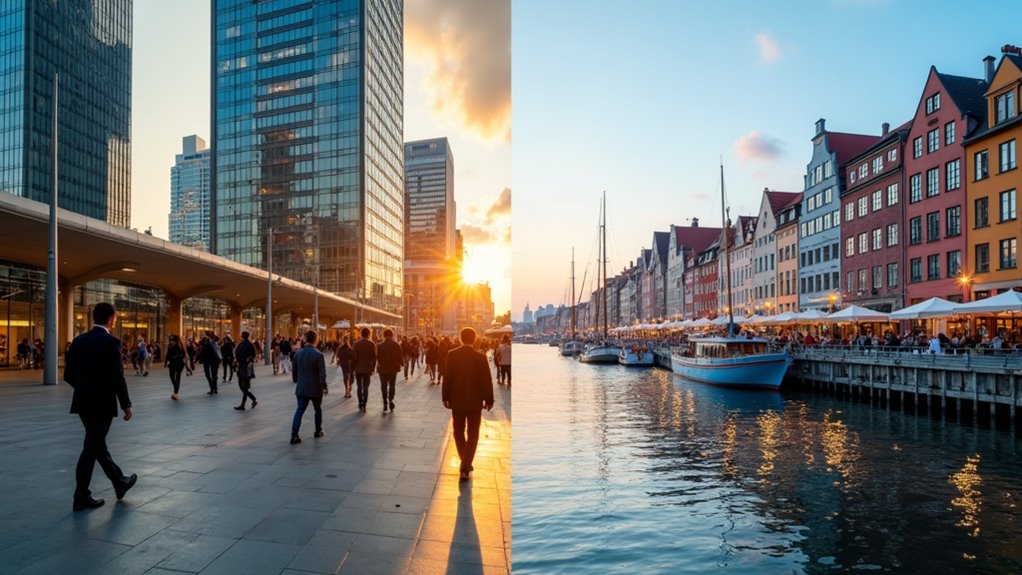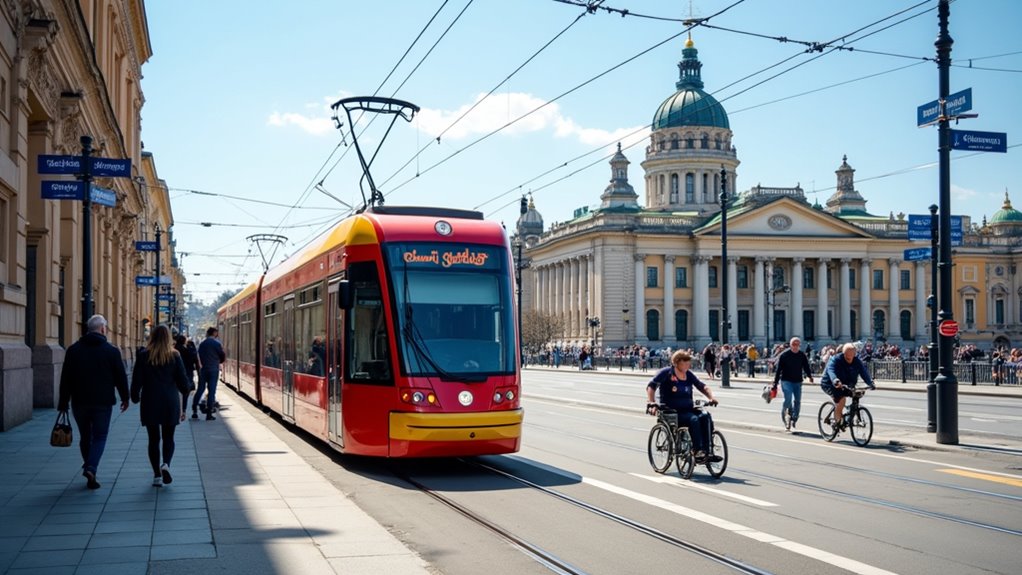Physical Address
304 North Cardinal St.
Dorchester Center, MA 02124
Physical Address
304 North Cardinal St.
Dorchester Center, MA 02124

In Poland's great city contest, discover whether Warsaw's urban elegance or Gdańsk's coastal allure deserves your precious vacation days.
Warsaw and Gdańsk offer distinctly different Polish experiences. Choose Warsaw for its metropolitan energy, extensive museums, and vibrant business scene across 517 km². Prefer Gdańsk if you’re drawn to maritime history, walkable Gothic architecture, and Baltic charm in a more compact 262 km² setting. Both cities boast excellent Polish cuisine and accessibility via public transport. Your ideal choice depends on whether you crave a dynamic capital city or an intimate coastal town with Hanseatic character.

When exploring Poland’s historical landscape, how do you choose between Warsaw and Gdańsk? Both cities offer compelling historical narratives that shaped the nation.
Gdańsk, founded by Mieszko I in the 10th century, flourished as a Baltic trade port under Hanseatic influence. You’ll find Gothic and Renaissance architecture throughout the city, with St. Mary’s Church exemplifying one of Europe’s largest brick churches. The city even hosted Copernicus and maintained voting rights in Polish royal elections. After 1466, Gdańsk became part of Royal Prussia and prospered through extensive trade via the Vistula River. Both cities have been influential in developing Polish cuisine that combines rich flavors with regional traditions.
Warsaw, established in the 13th century, rose to prominence as Poland’s capital. Its strategic position along the Vistula River fueled its economic growth. While devastated during the Warsaw Uprising in WWII, the city’s remarkable restoration efforts preserved its historical character. The Old Town now exemplifies Polish resilience and architectural heritage.
As you consider where to base your Polish adventure, the urban scale of each city will markedly shape your experience. Warsaw sprawls across 517 km² with nearly 1.8 million residents, offering metropolitan infrastructure including a two-line metro system and extensive cultural venues like the National Museum and Copernicus Science Centre. As one of Europe’s notable cities, Warsaw ranks among those with 1-2 million inhabitants, similar to Budapest and Hamburg.
Gdańsk presents a more intimate coastal setting with its 262 km² area and 486,000 residents. Its walkable Old Town contrasts with Warsaw’s car-centric outskirts, while maritime festivals and Baltic access define its character. Many travelers find this scale reminiscent of Zagreb’s atmosphere, with its blend of historical charm and manageable proportions.
Your urban experience will differ by:
Urban environments shape experiences through transportation choices, available recreational spaces, and ease of international access.

While exploring Poland’s economic landscape, you’ll discover substantial differences between Warsaw and Gdańsk that could influence your business prospects or job opportunities. Warsaw functions as Poland’s financial powerhouse, attracting over $1 billion in foreign direct investment for software development alone. Its remarkably low 1.4% unemployment rate indicates abundant job opportunities but potential hiring challenges for employers.
Gdańsk offers different advantages with its strategic coastal location, establishing itself as a vital logistics and trade hub with excellent global connections. Investment in innovation and high-tech sectors is driving growth throughout Poland’s major cities. Much like the Mediterranean destinations of Greece and Croatia, Poland’s distinctive cities each offer unique economic ecosystems shaped by their geography and historical development.
Both cities benefit from Poland’s projected 3.4% GDP growth in 2025 and access to EU funds for development projects.
If you’re seeking employment in finance or tech, Warsaw might be your best bet. For logistics, shipping, or trade businesses, Gdańsk offers compelling infrastructure and positioning advantages.
The cultural scenes in Warsaw and Gdańsk offer distinctly different artistic experiences that reflect each city’s unique history and character. Warsaw boasts an impressive metropolitan arts landscape with the National Museum housing over 830,000 artworks and contemporary venues like Zachęta National Gallery showcasing cutting-edge Polish art.
Gdańsk’s cultural identity is deeply tied to its maritime history and political significance, particularly evident in:
While Warsaw delivers big-city variety with international festivals and avant-garde theaters like TR Warszawa, Gdańsk provides a more intimate cultural experience connected to its historical significance. The city’s salt-washed, industrial-chic aesthetic has made it particularly appealing to hipsters seeking authentic cultural experiences.

Both Warsaw and Gdańsk showcase Poland’s affluent historical tapestry through distinctly different but equally enthralling attractions.
In Warsaw, you’ll find a meticulously reconstructed Old Town centered around its vibrant Market Square. Don’t miss climbing St. Anne’s Church bell tower for panoramic views or exploring the Royal Castle’s opulent chambers. The city balances history with green retreats—Łazienki Park stands out with its peacock-dotted grounds and palace-on-water. Unlike Krakow with its preserved medieval layout, Warsaw offers visitors a unique blend of historical reconstruction following its near-complete destruction during World War II. For immersive cultural experiences, visitors can attend Chopin Concerts that highlight Poland’s rich musical heritage.
Gdańsk offers maritime charm with its distinctive Hanseatic architecture along Długi Targ (Long Market) and the medieval Gdańsk Crane overlooking the Motława. St. Mary’s Church, the world’s largest brick church, provides stunning city vistas.
For poignant modern history, visit the European Solidarity Centre documenting Poland’s path to democracy.
Beyond the architectural marvels and historical sites, Poland’s culinary landscape offers a feast for your senses whether you’re wandering Warsaw’s metropolitan streets or Gdańsk’s maritime corridors. The two cities deliver distinctly different gastronomic experiences reflecting their unique regional influences.
While exploring these culinary havens, don’t miss:
For seasonal delights, time your visit around Easter for white sausage or Christmas for the traditional twelve-dish feast. If seeking international alternatives, consider that Portugal’s cuisine offers a stunning contrast to Polish flavors with its Mediterranean influences and seafood specialties. Don’t leave Poland without visiting Cukiernia Strzałkowski in Warsaw, a hidden cake shop where you can indulge in traditional Paczki and Sokół recommended by locals.

Whether you’re planning to navigate Poland’s historic capital or its Baltic port city, understanding your transportation options can considerably enhance your travel experience. Both cities offer excellent connectivity, with hourly trains covering the 336km distance in just 2h25m for 55-95zł.
Budget travelers will appreciate FlixBus services starting at 23zł, though the journey extends to 5 hours. The cheapest transportation option is carpooling through BlaBlaCar at only $11 per trip.
Within Warsaw, you’ll benefit from an extensive metro system complemented by trams and buses. Gdańsk relies primarily on its efficient tram and bus network operated by ZTM.
Warsaw’s international airport provides global connections, whereas Gdańsk’s Lech Wałęsa Airport serves mainly European destinations.
Both cities are wheelchair-accessible with low-floor public transport, and each offers bike-sharing programs—Warsaw’s Veturilo system being more all-encompassing than Gdańsk’s limited Mevo network.
You’ll find your ideal Polish haven whether you choose Warsaw’s bustling urban symphony or Gdańsk’s maritime melody. Warsaw stands tall like a phoenix risen from wartime ashes, while Gdańsk sparkles as a Baltic jewel with Hanseatic treasures. Don’t fret about making the “right” choice—both cities offer authentic Polish experiences with their own rhythm, flavor, and soul. Let your personal travel style guide your decision.